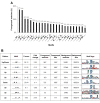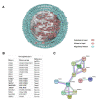Characterization of Kinase Expression Related to Increased Migration of PC-3M Cells Using Global Comparative Phosphoproteome Analysis
- PMID: 32859632
- PMCID: PMC7472454
- DOI: 10.21873/cgp.20210
Characterization of Kinase Expression Related to Increased Migration of PC-3M Cells Using Global Comparative Phosphoproteome Analysis
Abstract
Background/aim: Prostate cancer (PCa) is the second-most commonly occurring cancer among men, worldwide. Although the mechanisms associated with the progression of castration-resistant prostate cancer (CRPC) have been widely studied, the mechanism associated with more distant metastases from the bone remains unknown. This study aimed to characterize potential pathogenic kinases associated with highly metastatic PCa, that may regulate phosphorylation in extensively involved and diverse signaling pathways that are associated with the development of various cancers.
Materials and methods: A mass spectrometry (MS)-based comparative phosphoproteome strategy was utilized to identify differentially expressed kinases between the highly aggressive PCa cell-lines PC-3 and PC-3M.
Results: Among 2,968 phosphorylation sites in PCa cells, 151 differently expressed phosphoproteins were identified. Seven motifs: -SP-, -SxxE-, -PxS-, -PxSP-, -SxxK-, -SPxK-, and -SxxxxxP- were found to be highly expressed in PC-3M cells. Based on these motifs, the kinases p21-activated kinase (PAK)2, Ste20-like kinase (SLK), mammalian Ste20-like kinase (MST)4, mitogen-activated kinase kinase (MAP2K)2, and A-Raf proto-oncogene serine/threonine kinase (ARAF) were up-regulated in PC-3M cells.
Conclusion: PAK2, SLK, MST4, MAP2K2, and ARAF are kinases that are potentially associated with the progression of increased migration in PC-3M cells and may represent molecule regulators or drug targets for highly metastatic PCa therapy.
Keywords: Metastatic prostate cancer; kinases; phosphorylation; proteomics.
Copyright© 2020, International Institute of Anticancer Research (Dr. George J. Delinasios), All rights reserved.
Conflict of interest statement
The Authors declare no conflicts of interest.
Figures





Similar articles
-
Proteomic analysis of human prostate cancer PC-3M-1E8 cells and PC-3M-2B4 cells of same origin but with different metastatic potential.PLoS One. 2018 Oct 31;13(10):e0206139. doi: 10.1371/journal.pone.0206139. eCollection 2018. PLoS One. 2018. PMID: 30379883 Free PMC article.
-
Role of Runx2 phosphorylation in prostate cancer and association with metastatic disease.Oncogene. 2016 Jan 21;35(3):366-76. doi: 10.1038/onc.2015.91. Epub 2015 Apr 13. Oncogene. 2016. PMID: 25867060 Free PMC article.
-
The molecular function of kallikrein-related peptidase 14 demonstrates a key modulatory role in advanced prostate cancer.Mol Oncol. 2020 Jan;14(1):105-128. doi: 10.1002/1878-0261.12587. Epub 2019 Nov 28. Mol Oncol. 2020. PMID: 31630475 Free PMC article.
-
Ste20-like kinase SLK, at the crossroads: a matter of life and death.Cell Adh Migr. 2013 Jan-Feb;7(1):1-10. doi: 10.4161/cam.22495. Epub 2012 Nov 15. Cell Adh Migr. 2013. PMID: 23154402 Free PMC article. Review.
-
The Ste20-like kinase - a Jack of all trades?J Cell Sci. 2021 May 1;134(9):jcs258269. doi: 10.1242/jcs.258269. Epub 2021 May 7. J Cell Sci. 2021. PMID: 33961052 Review.
Cited by
-
Regulation of Cancer Metastasis by PAK2.Int J Mol Sci. 2024 Dec 15;25(24):13443. doi: 10.3390/ijms252413443. Int J Mol Sci. 2024. PMID: 39769207 Free PMC article. Review.
-
Post-Translational Modifications That Drive Prostate Cancer Progression.Biomolecules. 2021 Feb 9;11(2):247. doi: 10.3390/biom11020247. Biomolecules. 2021. PMID: 33572160 Free PMC article. Review.
-
Unravelling the Role of Kinases That Underpin Androgen Signalling in Prostate Cancer.Cells. 2022 Mar 10;11(6):952. doi: 10.3390/cells11060952. Cells. 2022. PMID: 35326402 Free PMC article. Review.
-
Advancements in Oncoproteomics Technologies: Treading toward Translation into Clinical Practice.Proteomes. 2023 Jan 10;11(1):2. doi: 10.3390/proteomes11010002. Proteomes. 2023. PMID: 36648960 Free PMC article. Review.
-
Emerging Proteins in CRPC: Functional Roles and Clinical Implications.Front Oncol. 2022 Jun 10;12:873876. doi: 10.3389/fonc.2022.873876. eCollection 2022. Front Oncol. 2022. PMID: 35756667 Free PMC article. Review.
References
MeSH terms
Substances
LinkOut - more resources
Full Text Sources
Medical
Research Materials
Miscellaneous
